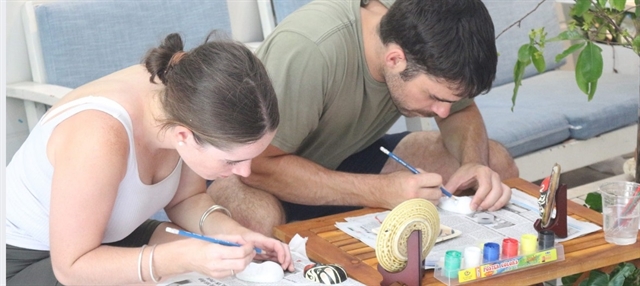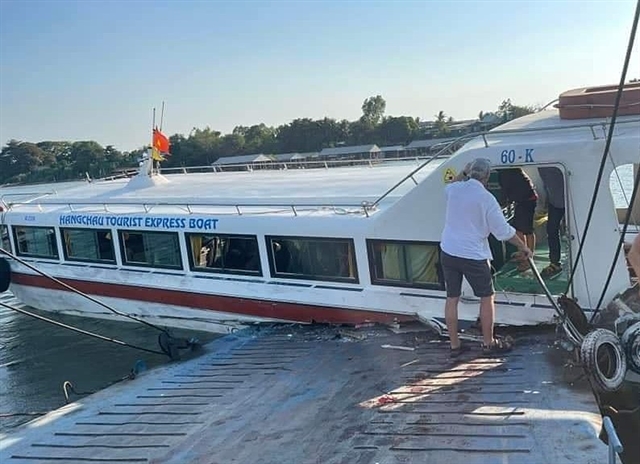 Talk Around Town
Talk Around Town

The recent news of children drowning in some provinces has raised alarms about the severity of the problem as the hot summer months get underway.
 |
By Thu Hằng
The recent news of children drowning in some provinces has raised alarms about the severity of the problem as the hot summer months get underway.
Media reported that 14 children died in the first three weeks of May.
In a recent serious accident, nine schoolboys from the same class drowned after jumping into a river in the central province of Quảng Ngãi on April 15.
Despite efforts to reduce the number of children drowning, the situation is still tragic.
A survey by the Child Care and Protection Department found that only 35 per cent of children in the Mekong Delta and 10 per cent in the Hồng (Red) River Delta can swim.
The rate of children who can swim in cities is lower than rural areas, according to the department.
With such low rates, drowning risks are still high, said Đặng Hoa Nam, the department’s director.
“It’s so sad hearing that every year when the summer vacation comes,” said Trần Tố Mai, a mother of a fourth grade student.
“Swimming is one of the most important life skills that people should be equipped with from a very young age. But I don’t think that many parents get that,” Mai said.
According to Nam, the reason for the high drowning rate is that adults’ awareness of proper child care has not improved.
Further complicating matters, most Vietnamese children lack swimming skills, he said.
In rural areas, the daily exposure to water hazards is significant.
Warning signs are lacking at many construction sites or dangerous ponds and holes, creating hazards for children, he added.
“You can swim, but it doesn’t mean that you can help other people in difficult situations,” Mai said. “Many people died when they tried to rescue others because they were not equipped with rescue techniques.”
The Ministry of Education and Training drafted a plan in 2010 to teach swimming in schools to prevent drowning deaths among children.
All provinces were instructed to enact trial swimming programmes in primary schools by 2015, particularly for third, fourth and fifth grade students.
However, few have managed to implement the plan, primarily due to a shortage of facilities and funds.
Most schools lack swimming pools.
It costs VNĐ700-800 million (US$31,270-35,740) to build a small swimming pool, and few schools have raised the necessary funds, said Dương Văn Bá, a ministry official.
To solve this situation, provinces and cities use mobile swimming pools made from rubber or parachute fabric, depending on their financial capacity, instead of waiting for funds from the State or ministries.
In Đà Nẵng especially, thousands of children in the city have been taught to swim that way in recent years.
Few city schools have swimming pools because they could not maintain the operations for many reasons.
To deal with this problem, they have co-ordinated with sport centres to organise swimming courses or offer free-of-charge swimming lessons to students. However, the number of children joining is limited.
Many parents said they were too busy. They could not arrange their schedules or did not have time to pick up their children from swimming class.
Nguyễn Mạnh Hùng, a father of an eight-year-old child in Hà Nội, said, “I want my son to join the class, but my wife and I are too busy. We don’t have time to pick up him.”
“I am free only on the weekend, but the weekend is the sport centre’s day off,” Hùng said.
Phan Quỳnh Liên, a mother of a sixth grade student, said the lessons should be a priority.
“I think he has not realised the importance and necessity of learning to swim,” she said. “Parents can arrange their schedules to help their children join swimming courses if they really want to.”
In some cases, schools wanted to build a swimming pool, but when they called for contributions from children’s parents, many said they could not afford it.
Some said their children can join a course for a small fee at a sport centre instead of contributing a lot of money for the school to build a pool.
Some even said that learning to swim was not necessary because most drowning incidents occur in rural areas.
I remember what happened three years ago when I told my husband’s sister, who lives in the northern province of Thái Bình, that my son would join a swimming course at a sport centre in Hà Nội during the summer vacation.
She told me it was unnecessary to spend money on that.
“You can let him stay with me one month only,” Nguyễn Thị Tuất said. “Every day, he will go to the river near my house and swim with other children in the village. He can swim easily.
“Every child in the village can swim without any class. And they can teach your son. Don’t be worried!”
I don’t know how to swim, so I was very scared and refused immediately.
In rural areas, ponds or rivers become regular swimming pools. There are no places to learn swimming.
Rural parents worry more about money for daily expenses or tuition for their children than worrying about other things.
According to Nam, the owners of construction sites where the drownings occurred will be held partly responsible for and strictly fined to reduce the number of child drownings.
The National Action Month for Children 2016 was launched at a ceremony held in the northern coastal city of Hạ Long in Quảng Ninh Province last Saturday.
Under the theme “For a safe life, accident and injury prevention for children”, the campaign aims to convey messages on preventing accidents and injuries, and ensuring a safe summer for children.
The launch of the action month kicked off a wide range of communication activities to raise awareness among families, schools and members of society on ways to facilitate safe environments for children.
At the end of the day, children need to be looked after by adults. — VNS









